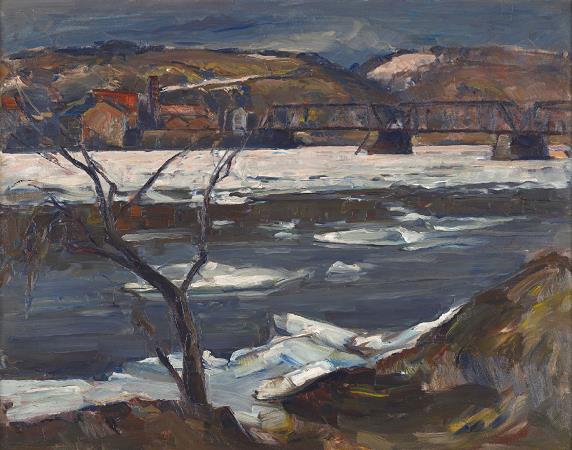Michener Art Museum. James A. Michener Art Museum is a private, non-profit museum in Doylestown, Bucks County, Pennsylvania, founded in 1988 and named for the Pulitzer Prize-winning writer James A. Michener, a Doylestown resident. It is situated within the old stone walls of a historic 19th-century prison and houses a collection of Bucks County visual arts, along with holdings of 19th-and 20th-century American art. It is noted for its Pennsylvania Impressionism collection, an art colony centered in nearby New Hope during the early 20th century, as well as its changing exhibitions, ranging from international touring shows to regionally focused exhibitions. The Museum has 40,000 square feet of public space, including a landscaped courtyard, a glass-enclosed, state-of-the-art event pavilion, an outdoor sculpture garden and terrace built in the original prison yard, seminar and conference facilities, a museum shop and café, and the George Nakashima Reading Room. The Martin Wing includes preparation areas and collection storage spaces. The idea of a museum in Doylestown dedicated to the works of the Pennsylvania Impressionists has been around at least since 1949, when local artist Walter Emerson Baum founded an informal committee along with Bucks County Superintendent of Schools Dr. Charles H. Boehm, and The Daily Intelligencer editor George Hotchkiss to explore the possibilities of the establishment of such an institution. In the 1970s Bucks County commissioners established the Bucks County Council on the Arts, an agency set up to manage federal funded artwork intended to be included in government building projects. Some of the artwork they collected was put on display at their headquarters in the Neshaminy Manor office in Doylestown Township. In 1974 the Council also helped establish a mobile art exhibit, the Artmobile of Bucks County Community College. In mid-1988 the Bucks County commissioners approved $650,000 to build an art museum in the recently closed Bucks County Prison. Bucks County Council on the Arts became the organization charged with running the institution and their collected works became part of the museum collection. James A. Michener, who grew up in Doylestown, took the lead in establishing the endowment, donating $500,000 as well as some of the paintings from his own private collection. The site was renovated by architects O'Donnell & Naccarato, Inc., from Doylestown, Pennsylvania. The warden's house and the control buildings were converted to office space and exhibition space. Part of the prison walls remain, which now provide a backdrop to the Museum's outdoor sculpture and event pavilion. The Museum was named the James A. Michener Art Museum, and opened to the public on September 15, 1988 at a ceremony presided over by Michener and his wife, Mari Sabusawa Michener. In 1993, the museum had its first major expansion designed by Lynn Taylor Associates from Doylestown, Pennsylvania which included larger exhibitions galleries and a storage vault. A few years later, in 1996, the Museum had its second major expansion which included the installation of the Mari Sabusawa Michener Wing, also designed by Lynn Taylor Associates. In 1999 there was a major expansion in the museums collection when Gerry and Marguerite Lenfest donated 54 Pennsylvania Impressionist paintings along with $3 million for the museum's endowment. In 2007, the Museum opened the Syd and Sharon Martin Wing, designed by architects RMJM Hillier from Princeton, NJ. This included a new 5,000-square-foot gallery space and additional administrative offices. The museum opened the new Edgar N. Putman Event Pavilion designed by KieranTimberlake, from Philadelphia, Pennsylvania. This new 2,700-square-foot all-glass structure with a solid roof and sliding doors on its east and west sides hosts Jazz Nights, lectures and special events. The Michener opened a satellite site in 2003, in New Hope, Pennsylvania, designed by architects Minno & Wasko. This facility closed in 2009. The Bucks County Prison, once on the site of the Michener Art Museum, originally opened in 1884. Philadelphia architect Addison Hutton designed an expanded facility that included a three-story warden's house and guardhouse control center in a T shape, using a combination of Italianate and Romanesque Revival styles. The architecture was inspired by Quaker ideas of reflection and penitence that dominated the American prison system in the 19th century. The overall design concept of the prison was modeled after the Eastern State Penitentiary in Philadelphia, built in 1829. The Bucks County Prison closed in 1985. The warden's house is a significant contributing property in the Doylestown Historic District, listed by the National Register of Historic Places in 1985.
more...




